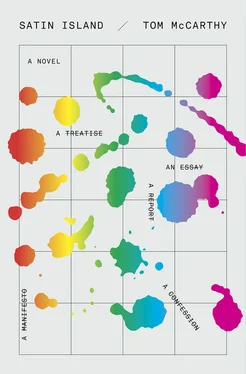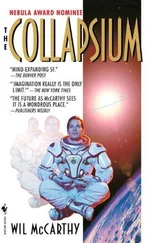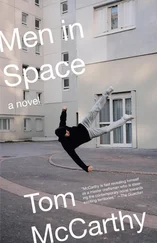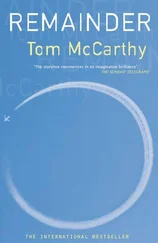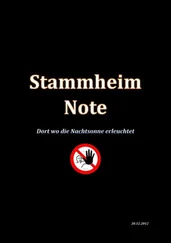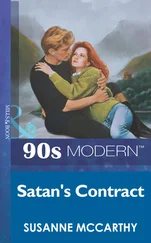7.2I had this vision often; as the weeks and months progressed, the edifice within it neared completion, its plan and outline growing more apparent. There were still unfinished bits, though: gaping lacunae where the carapace gave way to reveal guttery of half-laid floors, bare wiring, strata opening onto sub- and super-strata, down and up and every which way. The distances, the heights and depths and spaces in between, were huge — it was an entire metropolis, a Tower (and here, of course, the Company’s own logo wormed its way into the picture) of Babel. Peyman would always be there, in these visions: he’d be standing on the plain, perched on a balcony, or leaning against a half-completed buttress, consorting with engineers and princes, architects and sheiks and viziers, tweaking some finer point of the overall plan, or going over the logistics for the next phase, or some such activity — there in the thick of it, connected; and I, through my association with him, felt connected too. Even if this isn’t what the Project actually involved, this is how it presented itself to me, as I sat down in my basement, rode the tube, or drifted off to sleep.
7.3The meeting with the Minister took place. It’s odd to spend time in the company of somebody with power — I mean real, executive power: to hang out with a powerful person. You would imagine they exude this power at every turn, with each one of their gestures; that their very bodies sweat the stuff, wafting its odour at you through expensive clothes. But in fact, the thing most noticeable about this Minister was her lack of powerful aura. She seemed very normal. She wasn’t physically striking in any way: neither particularly tall nor particularly short; neither fat nor thin; neither attractive nor ugly. Her accent bore no traces of excessive privilege, nor of its masking. She must have been about my age, early forties. She was wearing sober, business-like clothes, with the exception of her shoes, which had small faux-fur tiger-skin stripes on them. We were sitting around a table: Peyman, Tapio, myself, this Minister and two of her staff. The way we were positioned allowed me to see these shoes, and what she was doing with them. As first one, then another person presented, responded, queried, clarified, proposed, counter-proposed and so forth, she rubbed one of her feet against the other, so that her right shoe’s toe, its outer edge, moved up and down against the side-arch of its neighbour. She performed this activity non-stop throughout the meeting, even when she herself was talking. I thought at first that she was scratching herself, that she had a bite or irritation on her left foot that was itching. Twenty or so minutes into the meeting, though, I had to abandon this hypothesis: while even low-level scratching has a kind of franticness about it, an angry, stop-start rhythm, her movement was so regular and methodical that it seemed almost automatic. With each upwards motion of the toe against the arch, the tiger-skin, its fur, would be drawn upwards, ruffled until its hairs all separated, each one bristling to attention; with each downward or return stroke these hairs would all lie back flat again, losing their individuality amidst the smooth, sleek flow of feline stripes.
7.4After the best part of an hour, I realized what this Minister was up to: she was attempting, with her right foot, to undo her left shoe’s buckle (which, unusually, fastened on the inward- rather than the outward-facing side). This, I realized as I watched her, was a quite ambitious undertaking. Buckles are finicky; once you remove hands from the equation, mastery of them becomes well-nigh impossible. Yet this is what her right foot, with a persistence and determination that I found increasingly admirable, was trying to do. The buckle had some give in it; the strap had been made pliant by (I presumed) repeated previous attempts to carry out this operation. At the same time, the strap still possessed enough stiffness to ensure that a push applied to its free end caused a whole stretch to be forced up towards — and ultimately through — the metal frame, rather than just crumpling. This didn’t, as I mentioned, happen all at once: it took an hour of tiny upward nudges, and of tiny corresponding downward smoothings of the shoe’s surrounding surface, for the strap to travel all the way up through the frame’s lower side; then, continuing its upward movement even though there was no further up for it to go, it snaked back over on itself in such a way that up turned into down with no perceptible change of direction — and, in performing this manoeuvre, cleared the central bar with all the grace of a pole vaulter, the prong falling away beneath its belly as it did so. Free of all encumbrances, the strap then slipped with rapid ease through the frame’s upper side; and presto! the operation was completed.
7.5As if this weren’t impressive enough, the Minister then proceeded, using the outside edge of her right shoe’s toe once more, to re-do the sequence in reverse. It took the best part of another hour; but she managed it as well. As soon as she’d returned the buckle to its starting position, its original state, she called the meeting to a close. I found the whole experience of observing this small episode, this drama that (due to the shape of the table, its supporting legs, the layout of our chairs and similar factors) I alone could see, deeply satisfying. How do you think it went? Peyman asked me after we had left. Oh, I answered: excellently.
7.6Back in the office, as our work on the Koob-Sassen Project kicked in and the general traffic-levels edged up, we started experiencing problems with our bandwidth. There was too much information, I guess, shuttling through the servers, down the cables, through the air. My computer, like those of all my colleagues, was afflicted by frequent bouts of buffering. I’d hear Daniel swearing in the next room —Fucking buffering! — and others shouting the same thing upstairs, their voices funneled to me by the ventilation system. The buffering didn’t bother me, though; I’d spend long stretches staring at the little spinning circle on my screen, losing myself in it. Behind it, I pictured hordes of bits and bytes and megabytes, all beavering away to get the requisite data to me; behind them, I pictured a giant über -server, housed somewhere in Finland or Nevada or Uzbekistan: stacks of memory banks, satellite dishes sprouting all around them, pumping out information non-stop, more of it than any single person would need in their lifetime, pumping it all my way in an endless, unconditional and grace-conferring act of generosity. Datum est: it is given. It was this gift, I told myself, this bottomless and inexhaustible torrent of giving, that made the circle spin: the data itself, its pure, unfiltered content as it rushed into my system, which, in turn, whirred into streamlined action as it started to reorganize it into legible form. The thought was almost sublimely reassuring.
7.7But on this thought’s outer reaches lay a much less reassuring counter-thought: what if it were just a circle, spinning on my screen, and nothing else? What if the supply-chain, its great bounty, had dried up, or been cut off, or never been connected in the first place? Each time that I allowed this possibility to take hold of my mind, the sense of bliss gave over to a kind of dread. If it was a video-file that I was trying to watch, then at the bottom of the screen there’d be that line, that bar that slowly fills itself in — twice: once in bold red and, at the same time, running ahead of that, in fainter grey; the fainter section, of course, has to remain in advance of the bold section, and of the cursor showing which part of the video you’re actually watching at a given moment; if the cursor and red section catch up, then buffering sets in again. Staring at this bar, losing myself in it just as with the circle, I was granted a small revelation: it dawned on me that what I was actually watching was nothing less than the skeleton, laid bare, of time or memory itself. Not our computers’ time and memory, but our own. This was its structure. We require experience to stay ahead, if only by a nose, of our consciousness of experience — if for no other reason than that the latter needs to make sense of the former, to (as Peyman would say) narrate it both to others and ourselves, and, for this purpose, has to be fed with a constant, unsorted supply of fresh sensations and events. But when the narrating cursor catches right up with the rendering one, when occurrences and situations don’t replenish themselves quickly enough for the awareness they sustain, when, no matter how fast they regenerate, they’re instantly devoured by a mouth too voracious to let anything gather or accrue unconsumed before it, then we find ourselves jammed, stuck in limbo: we can enjoy neither experience nor consciousness of it. Everything becomes buffering, and buffering becomes everything. The revelation pleased me. I decided I would start a dossier on buffering.
Читать дальше
